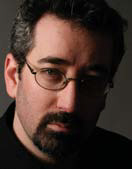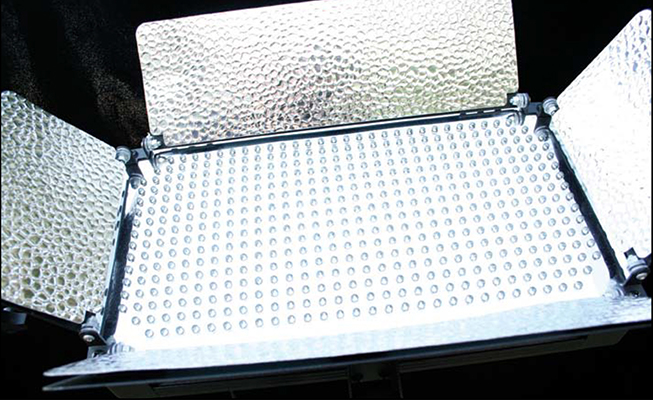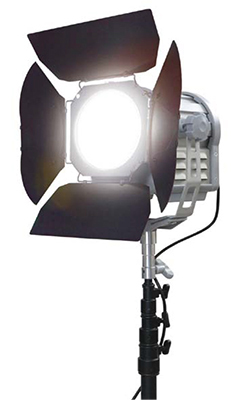LED Is Coming of Age

Jay Holben One of the woes of location shooting, especially on small productions when you can’t afford a generator or a qualified electrician to tap into existing power, is being limited to wall-socket power in the 15-amp or, at most, 20-amp variety. This limits you to, at most, a 2,000-watt fixture (which is definitely stretching the boundaries of safety).
In the HMI world, you’re limited to a 1,200-watt fixture (or perhaps the Arri 1,800W), if you can afford the HMIs. Fluorescent figures are a great alternative, but you’re limited to soft lights and they’re not necessarily compact or easy to transport.
COMING OF AGE
LEDs came on to the scene several years ago, but for quite a while they were small units without much output. Although they consume much less power than their tungsten or metal halide cousins, their output was a fraction of the traditional sources.
Finally, that is starting to change. LED is coming of age.

An LED fixture in action. Most LED panel fixtures have hundreds of single LED bulbs in rows that create soft sources, but can create multiple shadows if they are too close to your subject and they can be very harsh on talent’s eyes, making them squint. LED is an acronym for light-emitting diode. The modern LED was originally invented in the early 1960s, based on technological discoveries made at the turn of the 20th Century. Early LEDs were only capable of emitting a red light and at very low intensity, but further advancements paved the way to brighter red LEDs, then orange, green and, finally, in the mid 1990s, the blue LED.
As technology improved, creating brighter LEDs, techniques were employed to coat the inside of the plastic lens with phosphors to turn the bright blue light into “white” light.
LEDs create light by electroluminescence in a semiconductor material. This process happens when an electric current is passed through the semiconductor and individual electrons fill “holes” in the material. These holes are created when an atom lacks electrons (negatively charged ions) and, therefore, has a positive charge.
Semiconductor materials such as silicon can be “doped” to create these electron holes. Doping (no, not what you’re thinking) is the addition of elements into the silicon semiconductor to change its properties. Doping allows the manufacturer to create two separate types of semiconductors in the same crystal—positive and negative— with a boundary between the two types called the “p-n junction.” This is why they’re called diodes, meaning two terminals.
The p-n junction only allows current to pass through it in one direction. As electrons move from negative to positive through the junction, they fall into the “holes” and emit photons of light.
As blue/white LEDs emit the most practical light, most LED fixtures are naturally in the daylight color balance family, although with phosphor coatings, LEDs can also match the tungsten spectrum. High-end LED fixtures manufactured for the photographic industry are mostly very clean, with little to no green spike. Consumer grade or inexpensive LED fixtures often have a very high green content that needs to be filtered out.

Litepanels Sola 6 LEDs require very low power; output no heat (from the lamp itself); and have extraordinarily long lamp lives, typically in the 50,000- to 100,000-hour range. As a result of this efficiency, many long-term installations have already switched over to nearly exclusive LED technology.
In the United States and Canada, all traffic signals have been switching over to LED lamps since the mid 1990s. Once the three primary color LEDs were perfected, large screens could be manufactured with red, green and blue diodes clustered together in “pixel” formations to form pictures, like a television screen. Many outdoor giant screens are now made from LED lamps including Megascreen, D-Lite, Starvision, Monsterscreen and Sony’s massive Jumbotron.
These screens go as large as the Adi iConic 100, a 41-foot x 23-foot LED screen with a 47-foot widescreen diagonal picture— it’s an outdoor television larger than most cinema screens.
The advancements in LED technology have moved them into the viability range for film and video applications. Companies such as Brightline, Litepanels, Kino Flo, Nila, Element Labs, Zylight and more, are manufacturing LED fixtures specifically for production.
The typical LED is a 5 mm cylindrical shape, and although they can come in larger sizes and rectangular shapes, larger doesn’t necessarily equal more light. Brightness from LEDs comes not from size of the individual diodes, but rather from clustering many LEDs together.
The LEDs themselves are a fixed color, generally in a very narrow bandwidth, and they are not capable of changing color. Film and video fixtures therefore—just like their incandescent, gas-discharge or fluorescent cousins—are available in a specific color temperature.

Looking at the lens and reflector of a multicolored Red, Green and Blue LED fixture from ETC. The combination of the tri-stimulus arrangement allows the user to create practically any color of the rainbow by a combination of RGB, but does reduce the intensity possible for any given color. However, the small size of LEDs allows for many varying color diodes to be clustered together and activated at various intensities to create nearly any color in the visible spectrum with the possibility of dimming from one color to the next. This is the real benefit of LED fixtures—being able to have both daylight and tungsten in the same fixture and transition to any approximate Kelvin temperature in between by dimming between the two colors.
This nearly negates the necessity of color correction gel and makes a single, lightweight and compact fixture, extremely versatile for many different types of shooting environments.
The real maturity of LED technology is just starting: Fixtures like the Litepanels Sola Fresnels, which—despite their enormous size—can output the intensity and quality of a tungsten Fresnel at a fraction of the power consumption and heat generation.
Jay Holben is the technical editor of Digital Video and a contributor to Government Video. He is also the author of the book “A Shot in the Dark: A Creative DIY Guide to Digital Video Lighting on (Almost) No Budget.”
Get the TV Tech Newsletter
The professional video industry's #1 source for news, trends and product and tech information. Sign up below.
